November 4, 2005
Air Date: November 4, 2005
FULL SHOW
SEGMENTS
Alito: "An Agnostic" on the Environment
View the page for this story
The nomination of Samuel Alito to the U.S. Supreme Court has environmental activists digging through the judge’s fifteen years of appeals court opinions to find out what his record and ideology might be. Georgetown University Environmental Law Professor Richard Lazarus talks with host Bruce Gellerman about what we know, and don’t know, about Judge Alito and what effect his confirmation might have on environmental laws. (07:00)
Budget Watch
/ Jeff YoungView the page for this story
Proposed cuts in the federal budget are raising concerns about negative environmental impacts. The budget bills would open more land and coastline to oil and gas drilling. Living on Earth's Jeff Young reports from Washington. (04:45)
Blair on Climate Change
View the page for this story
Acting on a promise he made at the G8 summit in July, British Prime Minister Tony Blair hosted a conference in London this week on climate change that was attended by 20 nations. Blair stressed the importance of technology for the success of the Kyoto Protocol, which sets global targets for reducing greenhouse gases by 2012. (04:30)
The Haze Over Trade
/ Ingrid LobetView the page for this story
In the most recent in our series, "The Haze Over Trade," residents and regulators in southern California, frustrated over increasing trade related air pollution focus their most recent protests on railroad emissions. Living on Earth's Ingrid Lobet reports. (06:00)
Planting Sideways
View the page for this story
Host Bruce Gellerman interviews Lindsey Williams, a freshmen at Southern Methodist University. She won the Gloria Barron Prize for Young Heroes for inventing a new kind of irrigation system for crops. (03:00)
Fearless Flyer
/ Jean KumagaiView the page for this story
Rafal Zbikowski is making a science out of the common housefly. A professor at Cranfield University in England, Zbikowski hopes to develop a micro-air vehicle that could mimic the highly agile flight patterns of flies. Jean Kumagai from Spectrum Radio reports. (05:00)
Walking the Wakhan
/ Steve CurwoodView the page for this story
Mark Jenkins of Outside magazine retraces the steps of Marco Polo and takes to the Afghanistan part of the Silk Road called the Wakhan Corridor. Jenkins tells Living on Earth’s Steve Curwood that this remote land is a wild frontier with an unusual political history. (09:00)
The Mad Kayaker
View the page for this story
Roger Frymire has been patrolling the Charles River watershed in Massachusetts for over a decade, testing viral and bacterial levels that have been appearing at alarming highs. Living on Earth's Dennis Foley has this portrait of an average citizen who's putting the problem of water pollution on the radar. (07:30)
Singing Mice
View the page for this story
Scientists have discovered that mice sing, but they don't know what they're singing about. No one can hear mice because they sing at a pitch that is above the human hearing range. Researchers found that individual mice have distinct songs and when the pitch was lowered, they sound much like birds chirping. This week we end with an interesting Earth Ear. (02:00)
Show Credits and Funders
Show Transcript
HOST: Bruce Gellerman
GUESTS: Richard Lazarus, Tom Burke, Mark Jenkins
REPORTERS: Jeff Young, Ingrid Lobet, Jean Kumagai, Dennis Foley
[THEME MUSIC]
GELLERMAN: From NPR, this is Living on Earth.
[THEME MUSIC UP AND UNDER]
GELLERMAN: I’m Bruce Gellerman. Coming up: judging Judge Samuel Alito. We size up the Supreme Court nominee's track record on all things environmental. Frankly, there's not much to go on.
LAZARUS: There’s nothing about his record which suggests he’s anti-environmental protection. There’s nothing particular about his record to suggest he’s pro. I think that, mostly, his record suggests he’s an agnostic.
GELLERMAN: Also, trade and trade-offs. In southern California, record cargo traffic means more diesel pollution from trucks, ships and trains. And increasingly, people and politicians are growing impatient with state and federal inaction over the problem.
SCHEIBEL: Let's be real clear. People in my district and in southern California are dying from this pollution. Let's call it what it is.
GELLERMAN: And, up the creek WITH a paddle. The diary of a mad kayaker, this week on Living on Earth. So stick around.
[NPR NEWSCAST]
[THEME MUSIC]
ANNOUNCER: Support for Living on Earth comes from the National Science Foundation and Stonyfield Farm.
[THEME MUSIC]
Alito: "An Agnostic" on the Environment
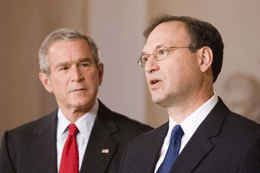
(White House photo by Paul Morse)
GELLERMAN: From the Jennifer and Ted Stanley Studios in Somerville, Massachusetts, this is Living on Earth. I'm Bruce Gellerman, sitting in for Steve Curwood.
When George Bush nominated federal judge Samuel Alito to the U.S. Supreme Court, the president specifically noted Alito’s environmental record, saying that as a federal prosecutor Alito moved aggressively against environmental crimes. To assess Judge Alito’s rulings and environmental record, we turn to Richard Lazarus who teaches environmental law at Georgetown University Law School.
Thank you very much for joining us, Professor.
LAZARUS: Thank you.
GELLERMAN: I did a Google search of Mr. Alito and he has only about three cases in which he sat that have relevance for environmental law, as I could find. Maybe four.
LAZARUS: Yeah, there are very few given the number of years he was on the bench, and given the fact that he was on the United States Court of Appeals for the Third Circuit which involves several significant eastern states. I think the luck of the draw, or the bad luck of the draw, led him not to have very many cases.
GELLERMAN: The one that I found very curious had to do with machine guns, of all things.
LAZARUS: Right, that’s the Rybar case. It was decided in 1996. That’s a classic case which, on its own terms, obviously isn’t about environmental law at all. But it’s of potential significance to environmental law because in that case Judge Alito dissented from that ruling on the ground that Congress had exceeded its authority under the Commerce Clause.
Now, the reason that’s so significant is that there are challenges being brought right now. In fact, there are two cases before the United States Supreme Court, a case called Rapanos v. United States and Carabell v. the United States. And in both those cases, individuals are claiming that the Clean Water Act may well be unconstitutional, for a rationale similar to that endorsed by Judge Alito in the Rybar case.
GELLERMAN: And that is that the Commerce Clause suggests that Congress has a role to play in interstate commerce, but not intrastate commerce?
LAZARUS: That’s right. Now, we can’t tell from the Rybar decision by itself what Judge Alito would do as Justice Alito in the Carabell case and the Rapanos case because, among other things, there’s been some intervening Supreme Court precedent since then.
GELLERMAN: The intervening cases that have occurred since his ruling, have they overturned or sustained his rulings?
LAZARUS: Actually, the rulings since then have gone the other way. When Judge Alito wrote his opinion in 1996, the Supreme Court had just announced a very significant case called United States v. Lopez in which they had struck down a federal statute making a crime to possess a firearm within a certain number of feet from a public high school. And the Supreme Court had said that basically exceeded Congress’ authority under the Commerce Clause.
Since then, and actually just last term, the Supreme Court announced a new ruling which I think everyone agrees cuts back on the Lopez ruling. What Judge Alito would do in light of that new Supreme Court ruling I think is an open question.
GELLERMAN: There’s this case PIRG – Public Interest Research Group – versus a company, Magnesium Electron, that environmental groups seem to be concerned about.
LAZARUS: Yeah, that’s a case that the Third Circuit decided in 1997. Judge Alito didn’t write the opinion for the court, but he joined the majority opinion which dismissed the environmental citizens for lack of standing. “Standing” refers to a requirement that the courts say exists under Article Three of the Constitution which provides, as construed by the Supreme Court, that to bring a claim in federal court you have to prove an injury in fact.
And what the Third Circuit held, with Judge Alito joining, was that the environmentalists in that case had failed to prove an injury in fact. But it was the standard the Third Circuit applied, it was a very exacting standard, a very exacting injury standard, a kind of standard which, actually, environmentalists feared after the Magnesium Electronic case would make it very hard, if not impossible, in lots of cases for environmental citizen suits to be brought at all.
GELLERMAN: Professor Lazarus, if Mr. Alito is approved by the Senate, does that change the balance, do you think, in terms of the Supreme Court and its perspective on environmental law?
LAZARUS: I think it does change the balance in some ways. Justice O’Conner was a really interesting vote on the environment. She was generally a conservative individual in many ways, but there were certain areas in which she tended to sort of go to the other side. I’ll give you a couple quick examples.
On questions of standing, for instance, the standing of citizens’ suits. In a case called Defenders of Wildlife v. Lujan – actually, it was Lujan v. Defenders of Wildlife – in the early 1990s, in that case, in an opinion written by Justice Scalia, the court said Defenders of Wildlife lacked standing to bring a claim under the Endangered Species Act. Justice Blackman wrote a very passionate dissent in that case accusing the majority of engaging in a, quote, “slash and burn expedition” through the environmental law of standing. Justice O’Conner joined that opinion in that case. She joined the dissent.
Similarly, in the 1990s, in a case called Babbitt v. Sweet Home, the Supreme Court, in an opinion written by Justice Stevens, endorsed the idea that modification of the habitat of a species could constitute a take, an unlawful take, of a species. Justice Stevens wrote the opinion, but Justice O’Conner joined that opinion there as well, with Justice Scalia and Justice Thomas, among others, in dissent.
So, in a variety of areas Justice O’Conner really did move over. I think she had sensitivity to some kinds of environmental protection concerns. She was a real westerner. She grew up on a ranch in the west. She harbored sort of a natural suspicion, I think, of the federal government. She also had a real sensitivity and appreciation for the environment; a real love of the outdoors and of the beauty of the natural environment.
GELLERMAN: How is it possible, Professor, in this day and age, that someone does not have a personal opinion about environmental issues? How could they not influence a person’s ruling on the bench?
LAZARUS: Well, I think that this Judge Alito, he may well love the environment, or not love the environment – although I don’t know anything yet about his personal life and his habits and his passions in that respect. But I don’t think there’s any sense of him, as a professional, having some kind of ideological agenda one way or the other with respect to the environment.
But there is some truth in what you say. I actually do strongly believe that the kind of way you live your life, and if you spend a lot of your free time, basically, enjoying and loving the natural environment, I do tend to think that affects how you approach cases which involve environmental issues. I think that’s true. I think it was true for Justice O’Conner. I don’t think we yet know enough about a Justice Alito to know, though, how that might influence him.
GELLERMAN: Professor Lazarus, thank you very much. I appreciate your time.
LAZARUS: Thanks a lot.
GELLERMAN: Richard Lazarus is a professor of law at Georgetown University School of Law in Washington, DC.
[MUSIC: Haywood “Mermaid” from ‘Music For Robots: Volume 1’ (Atomic Recording Company – 2005)]
Budget Watch
GELLERMAN: The U.S. Congress is trying to cut the federal budget, in part, to make up for the tens of billions of dollars spent so far to recover from Hurricane Katrina. To raise revenue, the budget bills would open more land and coastline to oil and gas drilling. But as Living on Earth’s Jeff Young reports, there are concerns the move will put environmentally sensitive areas from Alaska to Florida at risk.
[SINGING; DRUM BEAT]
YOUNG: Sarah James taps a caribou hide drum and sings just as she and her ancestors in the Gwich’in tribe of Northern Alaska have for centuries, except James is not in northern Alaska. She’s on a noisy street in Washington D.C., just off the Capitol grounds. James has held vigil here for nearly three months, hoping to keep oil drills out of the Arctic National Wildlife Refuge.
[SINGING]
JAMES: Singing a song, sing the song for the Refuge to stay that way and polar bears be healthy and caribou—everything that was born there. Because now, it’s maybe the last link of our fight. We don’t know.
YOUNG: For years Congress debated opening the Refuge’s coastal plain to energy production. Now, drilling supporters are close to success, with budget bills that include more than two billion dollars in revenue from the sale of mineral leases in the Refuge. Alaska Republican Senator Ted Stevens says it’s what Alaska wants, even the native villages.
STEVENS: Only one – one – has opposed this. And yet they’re the poster children for all these environmental ads you see. One, the Gwich’in village, opposes this.
YOUNG: Senate Democrats and a few moderate Republicans sought to strip the drilling language, but Stevens’ side narrowly prevailed. That ties the Refuge’s fate to a budget bill which, by Senate rules, cannot be filibustered. Attention now turns to the House of Representatives where a more controversial budget bill targets more than just the Arctic Refuge.
POMBO: It’s not just about opening up Alaska; it’s also about how do we increase domestic production. Alaska’s part of it, the Rocky Mountains are part of it, the deep sea is part of it.
YOUNG: That’s California Republican Congressman Richard Pombo who chairs the House Resources Committee. Pombo’s contribution to the House budget bill would also put more public lands up for sale to mining companies and expand offshore drilling for oil and natural gas. A federal moratorium prohibits new drills off most of the U.S. coast.
That moratorium has had broad political support from coastal states, especially Florida.
Pombo’s proposal would let a state opt out of the moratorium along its coast in return for a share of royalties. It would also allow a state like Florida to veto any drilling within 125 miles of its shores. In a major political coup, Pombo won the support of Florida Governor Jeb Bush.
POMBO: The fact that we have the governor of Florida endorsing the bill and supporting the bill should be a signal to people that this gives them the kind of protection that they need.
YOUNG: But some Florida Republicans still don’t trust the deal. Representative Connie Mack says he sees a big loophole: the bill apparently gives the Interior Secretary the final word on drilling.
MACK: We are not getting anything for that. In other words, we’re not protecting ourselves if the secretary can overturn what we’ve decided to do. And that does not give Florida a strong hand.
YOUNG: Mack says he would have a hard time voting for a budget bill that includes any offshore drilling in the eastern Gulf of Mexico. Environmental groups hope those divisions within Republican ranks will help their cause.
[FOOTSTEPS ECHOING DOWN A HALLWAY]
YOUNG: Wilderness Society President Bill Meadows is among the environmental leaders
working the halls of the Congress to keep oil rigs out of the Arctic Refuge. Meadows says many moderate Republicans are uneasy with the budget bill’s drilling and budget cut provisions.
MEADOWS: There are a lot of problems with budget reconciliation, and the House of Representatives, for example, is wrestling with how to deal with Medicare, how to deal with Medicaid, how to deal with higher education student aid programs, how do you look at after-school care. So you do end up picking up some interesting coalitions here.
YOUNG: Meadows hopes the disagreement about cuts in social services will doom the budget bill. So does Sarah James who pledges to keep her vigil for the Arctic Refuge, drumming, singing and struggling to be heard over the din of Washington traffic. For Living on Earth, I’m Jeff Young in Washington.
[SINGING; TRAFFIC]
[MUSIC: David Brusie “Understood” from ‘Music For Robots: Volume 1’ (MFR - 2005)]
GELLERMAN: Coming up: Southern Californians want to put the brakes on pollution from railroad yards. Keep listening to Living on Earth.
[MUSIC: Bill Frisell “We Are Everywhere” from ‘The Intercontinentals’ (Nonesuch – 2003)]
Blair on Climate Change
GELLERMAN: It's Living on Earth. I'm Bruce Gellerman. Declaring global warming a "major threat," British Prime Minister Tony Blair kept a promise he made this past summer at the G8 summit in Gleneagle, Scotland.
He brought climate change experts from twenty nations to London, and warned them that international treaties like the Kyoto Protocol may not be enough to reduce greenhouse gas emissions. Blair says a heavy dose of technology is what's needed.
We turn to Tom Burke, a long-time environmental advisor to the British government and UK businesses. Thanks for joining me, Mr. Burke.
BURKE: Pleasure. Glad to be with you.
GELLERMAN: You know, in regards to this conference in London, when all was said and done, was more said than done? Or did it actually accomplish something?
BURKE: I think it accomplished something. But I think it’s important to understand what it accomplished was really political rather than advancing the policy. I don’t think it was ever intended to make a breakthrough in terms of the negotiations on Kyoto or other international agreements.
I think the really important thing about this conference was it’s continuing the conversation that was started at Gleneagles in July that involves, really, all the world’s major players on climate change, about just how are they going to address this problem in what is becoming an increasingly urgent timeframe.
GELLERMAN: Hmm. Well, when you say it included everyone, the United States has not signed on to the Kyoto Protocol.
BURKE: No, exactly so. But the United States was present at this conference, as it was at Gleneagles. And one of the problems with the Kyoto Protocol is not so much that it was a particularly bad design, but that, really, when people signed up to it I don’t think there was a strong political foundation. And so, in a sense, what we’re having to do is go and backfill and create that political foundation now, and that’s what this conference was really about.
GELLERMAN: Do the technologies exist today that might forestall or prevent global warming?
BURKE: Yes, they do. The issue is not finding the technologies; the issue is deploying the technologies. The barriers to solving this problem are neither really technological nor economic. They’re institutional and political barriers. But they’re all well within our current competence, our current level of skill to solve, if we put the effort in. There’s a real effort-reward ratio here.
The point is, technology without investment is like a toy shop without any money to spend. We’ve got lots of technologies we could employ, but if we’re not willing to spend the money on them the toys will simply remain on the shelf.
GELLERMAN: So, where does that investment come from?
BURKE: A large part of it is going to be made anyway. I mean, we’re going to spend 17 trillion dollars this side of the world in the next 25 years on energy investment. So the core piece is, you have to use public funding to leverage the private funding that’s going to be made anyway.
GELLERMAN: Now, if you were advising the British government today, what would you tell them? What would be on the top of your list?
BURKE: The top of my list would be to say, ‘look, the only way you’re going to provide business with both a regulatory climate that has some certainty in it, and the incentives to make the technology shifts that are important, is by deploying a relatively low carbon tax and dedicating the funds from that tax to making the technology changes that we need to make.’ My sense is that the world is going to address this problem sooner or later; the faster you get going on that the better place your own technologies, your own businesses, are going to be to take advantage of the enormous opportunities that will come.
GELLERMAN: So, do you think the participants in this conference got it that the clock is ticking?
BURKE: I don’t think so. I don’t think even Prime Minister Blair who, in some ways, has been the most vocal leader, has yet really understood just how urgent it is. We have about two to three decades to get this problem right before, in a sense, we will have committed ourselves to an unstable climate, and that’s going to require much more aggressive action from governments. Not so much to try to constrain emissions as to invest in the technologies we know we have that can provide us with both the energy to fuel economic growth and a stable climate.
GELLERMAN: Tom Burke, a long-time environmental advisor to the British government, and former executive director of Friends of the Earth, is a member of the London Sustainable Commission. Well, Mr. Burke, thank you very much. I appreciate you taking the time.
BURKE: Pleasure. Nice to talk to you.
The Haze Over Trade
GELLERMAN: In just seven years, the number of cargo containers shipped into southern California has doubled and it’s predicted to quadruple over the next twenty years. It means more pollution around ports from the ships, trucks and trains that haul the freight . At the same time, new research shows that pollution from diesel engines is taking a toll on the health of residents of southern California. Heart disease, cancer and respiratory problems are on the rise, especially in children whose lungs are failing to fully develop.
Armed with this research, and frustrated by the lack of federal and state efforts to curb this growing source of pollution, some Southern Californians are demanding stricter controls, most recently on rail traffic. Living on Earth's Ingrid Lobet has the latest in our occasional series, "The Haze Over Trade."
LOBET: One evening recently, Rob Bradley, an operations manager for Burlington Northern Santa Fe Railroad, found himself making the case for a new railyard that would mean about one million truck trips per year on the 710 freeway, LA's most diesel-laden.
BRADLEY: Many may not realize that one double-stacked train can handle the equivalent of 250-280 trucks.
LOBET: No one disputes trains are the cleanest way to transport heavy cargo, and Bradley promised this would be no smoke-choked railyard. It would use electric cranes and natural gas or hybrid switch locomotives.
BRADLEY: BNSF is committed to making this the greenest facility in the country. The facility will set a new standard of environmental stewardship in southern California.
LOBET: Bradley made the pitch in the city of Long Beach where many people rely on international trade for work.
But air emissions from the ports have increased sixty percent since 2001 and an air toxic study six years ago informed residents their cancer risk is elevated. Communities have been organizing around the study ever since. City Council member Tonia Reyes Uranga carried the inhaler she uses for her asthma up to the microphone.
REYES URANGA: I'm really outraged that families of limited means are spending more on medical bills and medicines than on books and milk. My children, who were born on the West Side, suffer from asthma and respiratory illness. Everyone in our family now has one of these, except my husband. We now live in a census tract that is designated as a cluster area for throat and mouth cancer. How do I care for my family's welfare?
LOBET: Ophelia Hilliard had a pointed question.
HILLIARD: I would like to know, do they have board-certified pulmonologists? Pediatric pulmonologists who have backed up their studies? Or is this just pie in the sky?
LOBET: The new rail facility is only one place railroads are finding resistance now in southern California. In Sacramento, at the Air Resources Board, regulators thought they were making real progress when they quietly struck a deal with two of the nation's major railroads to remove 20 percent of the small particles in the air over rail yards. Almost immediately, they found themselves on the defensive.
[CROWD CHANTING, “We can’t breathe! Diesel kills!”]
LOBET: In the deal, the railroads agreed to turn off their heavy diesel engines when parked, rather than letting them idle for hours or even days. They promised to install automatic shut-offs on engines that stay in California and to measure air pollution at sixteen of the largest railyards. The Air Board's Mike Scheibel acknowledged to a packed room in Los Angeles that there are, quote, “tremendous health impacts because of railyard and port emissions.”
SCHEIBEL: We are pursuing as vigorously as we can regulatory and other mitigation approaches. We are doing this statewide.
LOBET: But Scheibel stressed states have very little authority to force interstate trains to do anything they don't want to.
SCHEIBEL: Federal law very significantly restricts our ability to regulate railroad emissions and operations. Therefore, we thought a mutual agreement between the state and the railroads was the most effective way to overcome these limitations.
LOBET: But in southern California, the voluntary agreement was seen as a backroom deal, cut to circumvent the stronger demands of the state’s most polluted region.
Meetings there drew more than 300 people. Resident Penny Newman had been working for two years with the same Sacramento regulators on other, stronger measures to address rail exhaust. She was incredulous that a deal was signed that short-circuited that effort.
NEWMAN: You sat there straight-faced. You took tours of our communities and, in many instances, you went into our homes. And all the while, you were using our bills as leverage in order to get those guys to the table and come up with this Mickey Mouse deal. You betrayed us.
LOBET: The anger isn’t only about process. Southern California regulators say they could have gotten a stronger agreement with the railroads. They scoff at a twenty percent reduction in particles and accuse state air officials of buckling. Some see the hand of the Schwarzenegger administration in the cooperative approach with a major industry. However it happened, regulators and railroad officials these days are hearing more from young people like Myra Gonzales
GONZALES: We do live in these communities. We breathe this air every day. Every day. When we go to school, we see these railroads.
LOBET: The high school student faced the much older members of the Air Resources Board and, by proxy, railroad officials.
GONZALES: You’re basically saying, ‘We don’t care. We don’t hear you.’ But we want our voice, and I know you hear it. Maybe it’s just time to listen.
[ENTHUSIASTIC APPLAUSE; CHEERS FROM AUDIENCE]
LOBET: One thing shipping companies could do is put more clean running train engines into service sooner. That would make for cleaner air not just in California but everywhere the trains run. Or some of the trade traffic could shift away from southern California to Seattle or San Francisco: somewhere where the clamor over air pollution isn’t as loud. For Living on Earth, I’m Ingrid Lobet in Los Angeles.
[MUSIC: L`Altra “Traffic” from ‘In The Afternoon’ (Aesthetics Records – 2002)]
Planting Sideways
GELLERMAN: If you ever want to find Lindsey Williams, you might want to try the garden – Lindsey can grow tomatoes like nobody’s business. With her homemade irrigation device she can double the yield using just half the water that mortal growers need. She calls it “Lindsey’s Nutrient Delivery System,” and it earned her one of this year’s Gloria Barron Prizes for Young Heroes.
Lindsey Williams is 18 years old. She’s from St. Joseph, Missouri. She’s a freshman at Central Methodist University, and she joins me on the line. Hi, Lindsey.
WILLIAMS: Hi.
GELLERMAN: Congratulations!
WILLIAMS: Thank you very much.
GELLERMAN: So, tell me about this irrigation system.
WILLIAMS: Well, the irrigation system is basically an L-shaped drip irrigation system. The system comes down and it’s actually stuck in the ground, and then it has two arms that come out of the system that run parallel to the ground. The plants are actually planted in raised mounds so the plant kind of sticks out of the side of the hill.
GELLERMAN: It’s gotta look a little weird having these mounds of plants growing sideways.
WILLIAMS: Well, the plant is growing sideways, but within two or three days the plant turns up to the sun. So, you can’t really tell that it’s been planted differently until you dig the plant up and you realize that when you get down to the root system the roots are actually growing in an L-shape.
GELLERMAN: And you can actually double the yield of the tomatoes?
WILLIAMS: Yes. What happens is, by the plant being planted transversely the roots are closer to the topsoil. So if you’re having a drought, they’re closer to the topsoil so they can take in more moisture because they’re only about two to six inches deep, compared to if they’re planted horizontally when they’re anywhere between 14 to 20 inches deep.
GELLERMAN: So, what do you do with all of these tomatoes and zucchinis?
WILLIAMS: Most of the produce goes to local food pantries in our area. I’ve donated right at forty thousand pounds of fresh vegetables.
GELLERMAN: Forty thousand pounds? Boy, that must be quite a scene when you deliver all these tomatoes to these food pantries.
WILLIAMS: We’ll bring in an entire truckload of nothing but boxes of tomatoes, because you can’t stack tomatoes on top of each other because they’ll bruise. But when we bring in potatoes and green beans, there are five-gallon buckets in the back of my dad’s Dodge Dakota.
GELLERMAN: How about other kind of vegetables or fruits or crops? Do you think this would work with them?
WILLIAMS: Well, I have tested the LND system on zucchini and squash and it came up with the same result, and I’m hoping someday to be able to use it on larger farming crops, such as maybe corn and soybeans.
GELLERMAN: You’ve invented the better mousetrap.
WILLIAMS: Right. It’s taking what we already know and just kind of making it better. Because there are irrigation systems out there right now but, just like anything else, with cars or anything, you just want to try to make it better than what it already is.
GELLERMAN: Lindsey Williams is inventor of “Lindsey’s Nutrient Delivery System.” She’s one of this year’s recipients of the Gloria Barron Prize which honors outstanding young leaders who made a significant positive difference to people and our planet. Lindsey, thank you very much.
WILLIAMS: Thanks for having me.
Fearless Flyer

GELLERMAN: When it comes to sheer, gravity-defying aerobatics, nothing beats the common housefly. It can buzz around the room at six miles an hour, and turn six full rotations in just a second. Let's see you do that.

KUMAGAI: Rafal Zbikowski never intended his career to end up this way, but these days he finds himself thinking, reading, and writing almost exclusively about houseflies.
ZBIKOWSKI: I’m an engineer by training, and I don’t have an idle interest in flies.
KUMAGAI: Zbikowski, a researcher at Cranfield University's Royal Military College of Science in England, is interested particularly in what makes the fly the world’s greatest aerial engineer.
ZBIKOWSKI: It can accelerate rapidly up to two times the acceleration of gravity in linear motion. But the real achievement is when it does rotations. It can rotate very rapidly – it can do six turns in a second, and it can achieve these six turns from rest in two hundredths of a second.
KUMAGAI: Zbikowski's interest in how flies fly is more than academic. He's hoping to build a micro air vehicle, or MAV, that mimics insect flight right down to the flapping wings.
ZBIKOWSKI: The idea was to have something that would be handheld and could fly. Handheld so that it could be easily carried around by an individual soldier, or a civilian, if there was a need for inspection. Because we have so many other things that can do outdoor reconnaissance, from satellites, to aircraft, to unmanned air vehicles and so on, but there is the problem of inspecting things inside. For example, the state of the art for inspecting pipes pumping noxious stuff is to send a fellow with a mirror on a stick looking for cracks. But if a crack is already there, he would inhale and we don't want that.
KUMAGAI: So far, researchers have had little success replicating the fly's agile movements. But they hope to learn how to by studying the insect's flight control system. Zbikowski says his research indicates is that flies use a completely different method for controlling their flight than would, say, an F-35 fighter jet.
Three Power PC computers running over a million lines of software code control the F-35's aeronautics, while the fly's flight commands emanate from a tiny part of its brain - a small knot of neurons with the computational power of your kitchen toaster. But the fly and the F-35 still have to obey the same laws of physics, so whatever the fly is doing in midair must be equivalent to the F-35's elaborate computations.
ZBIKOWSKI: Instead of computing the required information, the insect must somehow obtain it by different means, and this means sensors. In particular, their vision is very important. They will see patterns of interest and then fly toward these patterns, and therefore, things around them will streak past them, either along or around them. And from this they are able to infer their speed relative to this interesting object they are flying towards.
KUMAGAI: To explore their theories about insect flight, Zbikowski and his colleagues at Oxford and Cambridge Universities are beginning a series of experiments that, on the face of it, sound quite bizarre. First, they're constructing a miniature IMAX theatre, complete with a panoramic screen, inside of which they'll place a tiny rotating cage, a mini-version of the ones astronauts use to simulate the tumble of reentry from space. Then they'll strap a fly into the cage and show it a movie.
ZBIKOWSKI: In principle, this will be a flight simulator which will, again, move the insect through all the motions that it would experience in flight. We need to do both experiments and theory because, in order to understand all this, we have to describe this mathematically.
KUMAGAI: Once their experiments are completed, which could take several years, Zbikowski believes they will know enough to begin constructing a truly insect-like flying robot. Given that such a small, unlovely creature like the fly can teach us so much, will we pack away our fly swatters? Hmm. Probably not. For Living on Earth, I'm Jean Kumagai.
Related link:
"Fly Like A Fly" Spectrum magazine
[MUSIC: BumbleBeez81 “Cowboy Song” from `Music For Robots: Volume 1’ (Modular Records – 2005)]
GELLERMAN: Jean Kumagai is a reporter for Spectrum Radio, the broadcast edition of IEEE Spectrum magazine. To find out more about Rafal Zbikowski and his research on flies, buzz over to our website - Living on Earth dot org.
[MUSIC CONTINUES]
GELLERMAN: Just ahead: up the creek…with a paddle: the diary of a mad kayaker. Keep listening to Living on Earth.
ANNOUNCER: Support for NPR comes from NPR stations, and: The Charles Stewart Mott Foundation, online at M-O-T-T dot org, supporting efforts to promote a just, equitable and sustainable society; The Kresge Foundation. Building the capacity of nonprofit organizations through challenge grants since 1924. On the web at K-R-E-S-G-E dot org; The Annenberg Fund for excellence in communications and education; and, The W-K Kellogg Foundation. 'From Vision to Innovative Impact: 75 Years of Philanthropy; This is NPR, National Public Radio.
[MUSIC: Eric Weissberg & Steve Mandel “Dueling Banjos” from ‘Deliverance (Soundtrack)’ (Rhino/Warner Bros - 1990)]
Walking the Wakhan
GELLERMAN: It's Living on Earth. I'm Bruce Gellerman.
In the late 13th century, in search of a New World and new merchandise, Marco Polo traveled from Venice, Italy, to China, along the trade route known as the Silk Road. In those days, the main form of land transportation was horseback or foot, and travel took months, sometimes years.
Some 700 or so years later, Mark Jenkins decided to retrace Marco Polo’s steps through a stretch of the Silk Road known as the Wakhan Corridor. The Wakhan is in the northeastern part of Afghanistan, a remote, 200-mile-long strip of land that separates Pakistan and Tajikistan. It’s a region defined by geography, politics, and history, a place that seems to exists in another time.
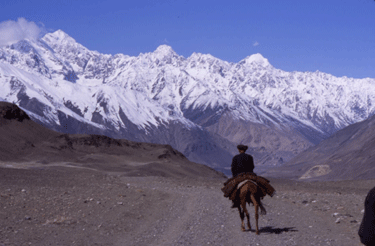
A Wakhi horseman rides across the Wakhan. (Photo: Mark Jenkins)
Mark Jenkins writes about his trek in the November issue of Outside magazine, and he spoke with Living on Earth’s Steve Curwood about why he wanted to walk the Wakhan.
JENKINS: It was one of those places that always fascinated me in world history. Afghanistan, itself, is a very odd country in some ways because the borders of the Wakhan and much of Afghanistan were created by the British and the Russians just at the turn of the last century, around 1900, to create a buffer zone between two world powers.
And that’s what the Wakhan is, it’s just this strip of land that separates basically the mountainous Tajikistan and all the Pamirs from the mountainous Pakistan and the Hindu Kush. And I knew that the region was extraordinarily remote, and any time you go someplace remote you have the opportunity to kind of step back in time and see the way humans lived a hundred, two hundred, three hundred years ago.
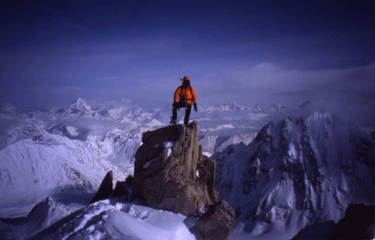
Doug Chabot, Mark Jenkin’s walking partner, on the summit of Koh-e-Bardar. It’s the first ascent in the Wakhan since the 1970s. (Photo: Mark Jenkins)
CURWOOD: What is the physical landscape there in the Wakhan? What’s it like? Can you describe it for me, please?
JENKINS: Sure. I guess you’d just have to imagine a landscape somewhat like Nevada. There’s a valley floor; it’s very dry. There are no trees. There’s a river, the famous Oxis River, that once in Greek mythology separated the known world from the unknown world, passes right down the middle of the Wakhan Corridor. On both sides you’ve got these mountains that rise ten to fifteen thousand feet, right off both sides. So, it’s phenomenal geographic architecture, frankly. It’s just stunning.
CURWOOD: At one point in the story you wrote about this, Mark, you describe the area as medieval. How so?
JENKINS: Medieval in the sense…I mean, it wasn’t meant to be descriptive of some place that’s extraordinarily barbaric, but someplace where the culture is much closer to the ground. In the Wakhan there are no roads. There are no TVs. There’s no electricity. There’s no running water. People live very frugally and it’s a very hard life.
On the western side of the Wakhan, the Wakhis there are traditional farmers, and they’ve got yaks and they pull, you know, a handmade plow, and they pound the barley and they make bread. And in the eastern part of the Wakhan the Kyrgyz, Turkish culture, are sheep herders, and they live in yurts. So, it’s a very simple, a very communal, and a very tough life.

Women in Sarhadd collecting water. (Photo: Mark Jenkins)
CURWOOD: So, you’re on this trek, on foot. Tell me what it would be like when you would stop for the night. Who might take you in? What did they do? How were they making a living?
JENKINS: Making a living is not the right term, probably. There’s not really an economy of any sort; it’s subsistence living. They do trade. They may, for instance…the Kyrgyz, who run sheep, huge herds of sheep, and live in nomadic kind of clusters of yurts. And they have a summer camp and a winter camp, and they’re not unlike the Sioux Indians or something like that following the buffalo herds, although these were domesticated.
What would happen going into a village? We were always taken care of, we were always welcomed as these kind of long lost travelers. They wanted to hear stories. We did have Safraz, our interpreter, with us, so we would sit around the hearth and tell stories about our land and the world we came from, and they would tell us stories about their lives.
CURWOOD: And what would they expect from you in return?
JENKINS: You know, this is always an interesting thing about traveling in remote places. Because you are, you’re a guest in their country, and I think one of the things always expected of you is to share your life. They want to know what it’s like in America. You know, they’ve been to Kabul or something like that. They’ve seen videos. They want to know: do we really fly airplanes? Or does everybody own a car? They want to know about the greater world about them.
Sometimes they need help. I’ll give you a small example that was just really fun. In a small Kyrgyz village near the end of the Wakhan we came to a yurt where the chief had bought a generator, a five horsepower generator. He’d bought it about eight months ago and brought it in on horse, a week on horseback, hoping that his village, just a collection of probably nine yurts, would have lights for the winter.
This is a place that can get between two to ten feet of snow all winter long, extremely cold. Extremely cold. You know, this is at 14,000-15,000 feet, temperatures dropping below 40-below in the winter. No lights. And so he bought this generator, gas-powered, and, sure enough, it worked one day and then it broke. And the village once again – just like they had for the last 500 years? 5,000 years? – had gone through the winter with no lights, other than candles.
So we get there, and the first thing he would like us to do is take a look at this generator. [LAUGHS] Now, luckily, Doug Chabot, my climbing partner, and I had both grown up mowing lawns as kids, right? And it’s the same kind of engine, so we set to work fooling with it, you know, pulling the choke and checking the mixture of the oil and the gas, and we just played with it for about an hour.
CURWOOD: So, what happens the first time you pull the cord?
JENKINS: Nothing. [LAUGHS] And you can just feel the kind of, ‘oh, my god! These guys they come, they should know engines! They live in a world of machines! They should be able to fix this.’ Well, we kept playing with it, and pulling the draw cord, and finally the thing fires to life and the whole village erupts in just enormous pleasure. Just yelling! It was a great moment, it was.
And he’d also brought with him this box of electrical supplies – wires, light bulbs – so immediately we begin stringing the entire village, just like you’d string Christmas lights, with lights. And, of course, they kill the biggest sheep of the herd – a herd of like 800 – they kill the biggest sheep right off the bat, skin it right there, gut it, throw the meat in the pot. And then, about two hours later, we’re served what are considered the delicacies of that culture, and that happens to be the brain and the balls of the sheep. And that’s what we ate.
CURWOOD: Yeah? Which tastes better?
JENKINS: Brains are really soft, and testicles of almost all animals can be a little gristly.
CURWOOD: After your trip into the Wakhan – and, really, a trip back to what Afghanistan was like a hundred or even two hundred years ago – what should folks in the west understand about Afghanistan?

A shepherd and his son in the Wakhan. (Photo: Mark Jenkins)
JENKINS: That it’s a very complex country. It’s got a complicated history. You’ve got foreign forces there, you’ve got fundamentalist forces there, you’ve got an opium trade, you’ve got enormous poverty. And that combination is tough to solve. It takes time, it takes compassion, and it takes a lot of education.
You often hear this from the Afghanis, and you ask them, ‘well, what is their country?’ And they said ‘well, you know, when God made the world he had all these leftover pieces, and he put them all in Afghanistan.’ And it somewhat describes the kind of disparity of the landscape and the complexities of the cultures and the languages. It’s just a huge mishmash of everything.
GELLERMAN: Mark Jenkins speaking with Living on Earth’s Steve Curwood. Jenkin’s article on the Afghanistan Wakhan Corridor is in the November issue of Outside magazine. To see photos of the Wakhan, walk on over to our website, Living on Earth dot org.
Related links:
- “Afghanistan: A Short Walk in the Wakhan Corridor” Outside Nov. 2005 issue
- Mark Jenkins website "The Hard Way"
[MUSIC: Aziz Herawi “Pashtu” from ‘Memories of Herat: Instrumental Music of Afghanistan’ (Music Of The World – 2000)]
The Mad Kayaker
GELLERMAN: New England has—so far—been spared the more devastating effects of this year’s hurricane season, but residual storms traveling up the east coast have caused a lot of flooding and overflowing of sewers.
In the Boston area, aging drainpipes, designed to flush storm water into Charles River Watershed, have been dumping thousands of gallons of untreated sewage into the river. And it's not just when there are storms.
But one man has refused to go with the flow, and for more than a decade, he has been urging communities to clean up their act. Living on Earth’s Dennis Foley has this portrait of the “Mad Kayaker.”
[RAIN AND WIND; SOUND OF UNLOADING KAYAK; WALKING DOWN TO RIVER]
FOLEY: It’s 4:30 in the morning on this chilly, rain soaked New England day. While most people are still a good hour away from hitting the snooze button on their alarm clocks, Roger Frymire is wide awake and lugging his plastic kayak down to a local river’s edge.
[WALKING IN RAIN WITH CLUNKING KAYAK]
FOLEY: Oddly enough, this is exactly how he likes his weather conditions, thank you very much.
FRYMIRE: We got .27 of an inch last night, which is going to give us some very good overview since it was a short storm….
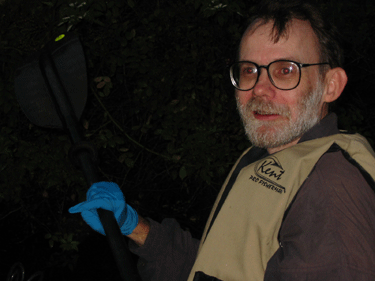
(Photo: Dennis Foley)
FOLEY: Roger Frymire is an unassuming, 49-year-old retired computer scientist. This elfish and spectacled fellow has taken on a new mission in life: clean water advocacy. Though some folks might consider what he’s been doing with his time a bit eccentric, to several watershed organizations he’s a one-person clean water army.
[FRYMIRE LOADS EQUIPMENT INTO KAYAK]
FOLEY: On this particular morning, we’re by the edge of the Mystic River in Medford, Massachusetts. Frymire loads his boat to prepare for a trip upstream to Alewife Brook. There, he’ll test water around three storm water drainage pipes, also known as Combined Sewer Overflows. These 19th Century era pipes were designed to steer excessive storm water directly into the rivers in order to prevent flooding. Nearly a dozen of these pipes still exist along Massachusetts’ rivers despite efforts to replace them with newer filtration systems.
FRYMIRE: Any time you get a rain, everything is washed off the land. You’ve got animal feces, you’ve got water washed off the streets into storm drains, and a big problem on Alewife Brook is actually sewage – though this wasn’t a large enough rain to set off the Combined Sewer Overflows which make the whole river stink when it rains intensely.
FRYMIRE [LISTS EQUIPMENT AS HE LOADS]: …bag of assorted sample vials and equipment. On top of it, I’ll set my meter…
FOLEY: The importance of his floating science lab, strapped to the top of his kayak with bungee cords, cannot be overstated. After all, his water samples will be submitted to the New England EPA and tested at the agency’s lab. But, to be clear, Roger Frymire is employed by no such organization. In fact, he works alone, and at least some of his motivations are personal.
FRYMIRE: After retiring in the late `80s I started kayaking, and after a few years of that I noticed that any time I dunked into the river, the Charles River, no matter which direction I paddled, in a little bit I’d smell sewage. And I got sick of it.
FOLEY: Frymire has collected an estimated 1,500 water samples along the 80 miles of the Massachusetts’ Charles River and the 17-mile-long Mystic. Many local water commissions regard him as THE authority on the waterways here. His services come free of charge. He just hopes that the towns sharing acreage along the water’s edge will at least try to meet standards of the 1972 Clean Water Act.
[KAYAK LAUNCHES INTO THE RIVER]
FOLEY: Frymire launches his trusty dented and duct-taped vanilla-white kayak into the quiet waters of the Mystic. The work he’s been doing has earned him a playful moniker from one EPA biologist: “The Mad Kayaker”.
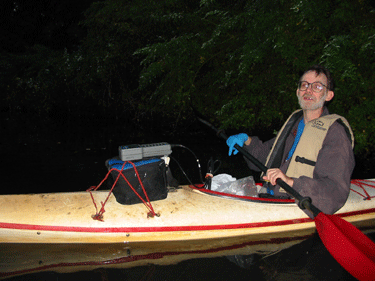
(Photo: Dennis Foley)
[PADDLING UP RIVER AND CHATTING]
FOLEY: Today he hopes to find – or rather, hopes not to find – high bacterial counts that include fecal coliform. Fecal bacteria is commonly found around many of the river drainage pipes after heavy rainstorms such as the one the night before.
FRYMIRE: Oh, the waters are starting to appear just a little bit gray, unfortunately, which to me means that there’s been some sewage in the water overnight.
FOLEY: At times, he’ll employ less scientific methods in his quest. His nose has become quite adept at detecting any peculiar odors unbecoming of the river’s normal smells, and he’s also got a keen eye out for...
FRYMIRE: Objectionable floatables.
FOLEY: Objectionable floatables?
FRYMIRE: Anything from hypodermics, condoms, sanitary pads, rafts of toilet paper or even the bobbing brown lumps occasionally. None of it’s very appetizing.
FOLEY: Indeed.
[PADDLING UP RIVER]
FOLEY: Up river, our boats glide through waters lush with flowering lily pads, swaying green reeds and a habitat active with wild ducks and geese.
[SOUNDS OF DUCKS AND GEESE]
FOLEY: Quite by accident, we startle a great blue heron breakfasting along the river shoreline.
FRYMIRE: Pretty.
FOLEY: Beautiful.
FRYMIRE: He flushed back behind us so we’ll only bother him once today.
FOLEY: But strewn beneath the waters is a veritable junkyard, abundant with sunken shopping carts, rusted bicycles and enough baseballs, tennis balls and basketballs to outfit an entire high school athletic department. Frymire takes this in stride.
FRYMIRE: After awhile, you have to let the small problems slide.
[SOUND OF FRYMIRE TAKING WATER SAMPLES]
FOLEY: We’ve arrived at one of the aging pipes, a toothy looking maw frowning under the weight of decay. Frymire dons blue rubber gloves as he takes several test tube samples directly from the murky gray-brown water’s surface.
FRYMIRE: Still waiting for the dissolved oxygen to stabilize.
FOLEY: He’ll report his findings directly to places such as the EPA, and to his old training grounds, the non-profit Charles River Watershed Association. The CRWA was founded in 1965 in response to public concern about the decline of the Charles River’s water quality. The group provides EPA-approved training for people like Roger Frymire interested in helping their cause.
Kate Bowditch, the group’s senior environmental scientist, echoes what many in water quality advocacy groups believe: that citizen water watchdogs are essential.
BOWDITCH: You need to have citizens out there who really care about what’s going on and who are willing to say something about it, who are willing to put in some of their own time. You need the Roger Frymires of the world. There’s not a town or a city or an industry that can resist that kind of organization and that kind of data and that kind of information.
[EPA LAB DOOR ENTRANCE]
MAN: OK, Roger, what do we have today?
FRYMIRE: We have one sample, No. 99...
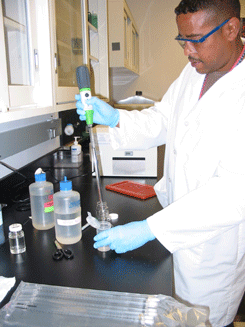
Biologist Nathan Rains processes water samples at the Mass-EPA laboratory. (Photo: Dennis Foley)
[WATER VIALS SHAKING]
FOLEY: It will take these samples a full 24 hours to incubate. Past samples have revealed “critter” levels, as Frymire puts it, 10,000 times this states legal swimming levels. Some may ask why it should take a volunteer like Roger Frymire to deliver evidence of contaminated water. That’s the EPA’s job, isn’t it? But EPA lab biologist, Tom Faber, points out:
FABER: There’s limited resources. I mean, we can’t do everything. We can’t sample every river and every pipe. There’s thousands and thousands of pipe.
FOLEY: Faber acknowledges Frymire helps fill in the gaps.
FABER: Because Roger’s out on the river he knows the river very well. He kayaks it daily in some cases, so he’s able to bring samples in, we’re able to analyze them. We work together on some of the problem areas.
FOLEY: Over the years, Frymire has been credited for making towns fix a significant share of damaged drainpipes, help control water contamination levels, and change water pollution permit rules. He’s not one to rest easy on his laurels, though.
[SOUND OF PADDLING]
FOLEY: Frymire is determined to continue improving the quality of Boston’s waterways, even if his actions are a bit unorthodox.
FRYMIRE: After all, somebody’s gotta be a little off their noggin’ to go out in all this sewage and stink voluntarily.
FOLEY: For this “Mad Kayaker,” a little “off your noggin’” seems to have gone a long way.
FRYMIRE: (LAUGHS)
FOLEY: For Living on Earth, I’m Dennis Foley in Boston.
[SOUND OF PADDLING]
Related links:
- Charles River Watershed Association
- EPA New England Regional Office
- Mystic River Watershed Association
Singing Mice
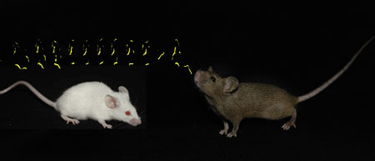
(Courtesy of Public Library of Science)
[MOUSE CHIRPING: “Ultra Sonic Songs of Male Mice” from Washington School of Medicine, St. Louis, Missouri (PLOS Biology)]
GELLERMAN: We leave you this week with a love song.
[MORE CHIRPING]
GELLERMAN: That’s the slowed-down call of a male mouse who’s just caught wind of a female.
Biologists have long known about mouse music, but recently researchers at the University of Washington in St. Louis discovered that the tunes follow a pattern of repeating syllables, much like bird songs.
The researchers think males use these songs to attract mates during courtship. If they’re right, mice would join whales, bats, and humans as the only mammals known to serenade the objects of their desire.

(Courtesy of Public Library of Science)
[MOUSE NOISE]
GELLERMAN: Doesn't exactly turn you on? Well, using a sophisticated digital decoding device, we've been able to fine tune the frequency, and discovered what the male mice were actually singing:
[MOUSE SOUNDS CROSSFADE TO BETA BAND SONG: She’s the one for me…She’s the one for me….She’s the one for me…]
[MUSIC: The Beta Band “She’s The One For Me” from ‘The Three EPs’ (Astralwerks – 1999)]
GELLERMAN: We’ll let the intelligent design folks figure that one out.
Related link:
"Ultrasonic Songs of Male Mice" research article
Living on Earth is produced by the World Media Foundation. Our crew includes Ashley Ahearn, Chris Ballman, Eileen Bolinsky, and Susan Shepherd - with help from Christopher Bolick, Kelley Cronin, James Curwood and Michelle Kweder.
Our interns are Brianna Asbury, Kevin Friedl and Emily Torgrimson. Alison Dean composed our themes. You can find us at LOE dot org. Steve Curwood returns next week. I'm Bruce Gellerman. Thanks for listening.
ANNOUNCER1: Funding for Living on Earth comes from the National Science Foundation, supporting coverage of emerging science; and Stonyfield Farm. Organic yogurt and smoothies. Stonyfield pays its farmers not to use artificial growth hormones on their cows. Details at Stonyfield dot com. Support also comes from NPR member stations, the Ford Foundation, Geraldine R. Dodge Foundation, and the Saunders Hotel Group of Boston's Lennox and Copley Square Hotels. Serving you and the environment while helping preserve the past and protect the future, 800-225-7676.
ANNOUNCER2: This is NPR, National Public Radio.
Living on Earth wants to hear from you!
Living on Earth
62 Calef Highway, Suite 212
Lee, NH 03861
Telephone: 617-287-4121
E-mail: comments@loe.org
Newsletter [Click here]
Donate to Living on Earth!
Living on Earth is an independent media program and relies entirely on contributions from listeners and institutions supporting public service. Please donate now to preserve an independent environmental voice.
NewsletterLiving on Earth offers a weekly delivery of the show's rundown to your mailbox. Sign up for our newsletter today!
 Sailors For The Sea: Be the change you want to sea.
Sailors For The Sea: Be the change you want to sea.
 The Grantham Foundation for the Protection of the Environment: Committed to protecting and improving the health of the global environment.
The Grantham Foundation for the Protection of the Environment: Committed to protecting and improving the health of the global environment.
 Contribute to Living on Earth and receive, as our gift to you, an archival print of one of Mark Seth Lender's extraordinary wildlife photographs. Follow the link to see Mark's current collection of photographs.
Contribute to Living on Earth and receive, as our gift to you, an archival print of one of Mark Seth Lender's extraordinary wildlife photographs. Follow the link to see Mark's current collection of photographs.
 Buy a signed copy of Mark Seth Lender's book Smeagull the Seagull & support Living on Earth
Buy a signed copy of Mark Seth Lender's book Smeagull the Seagull & support Living on Earth

